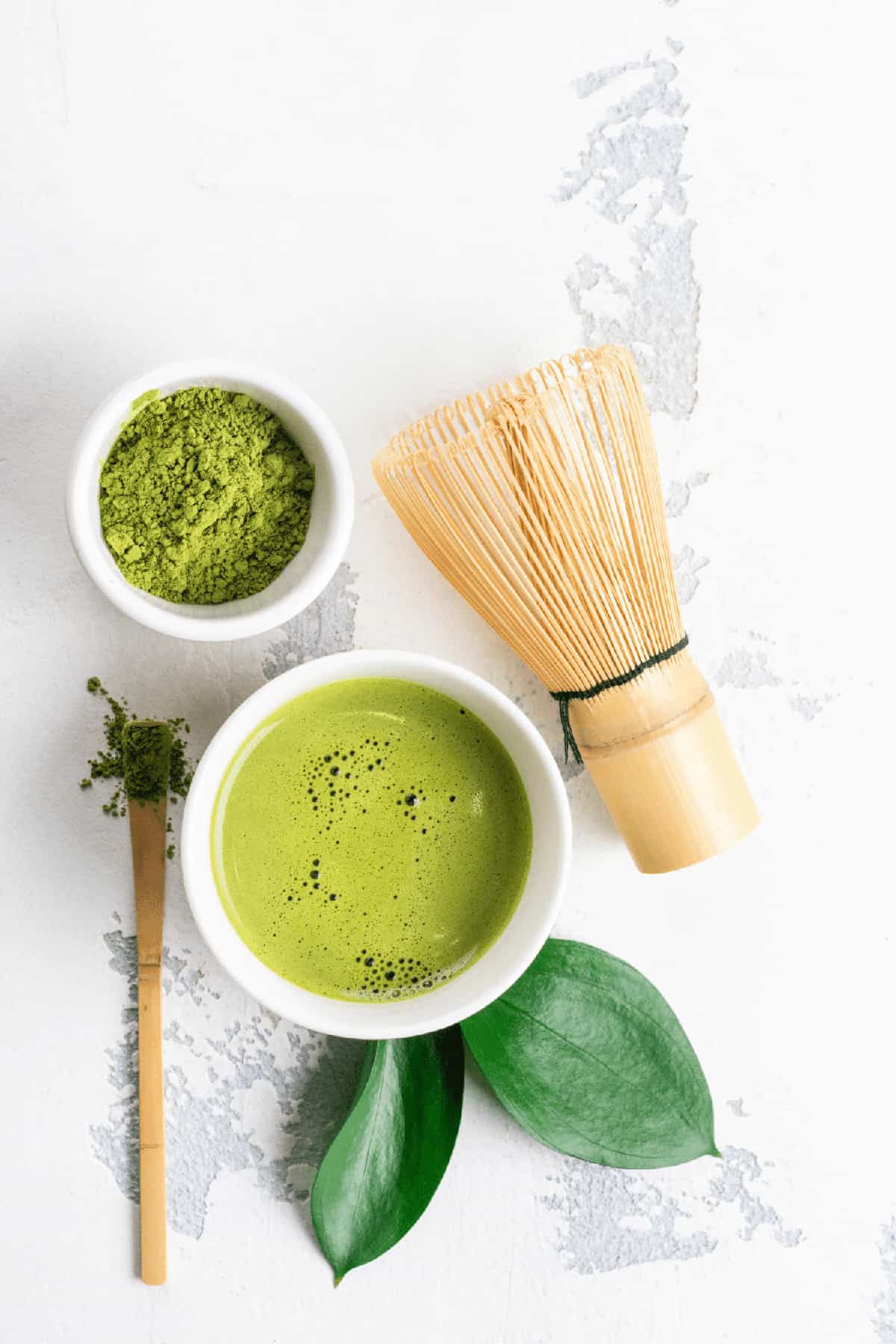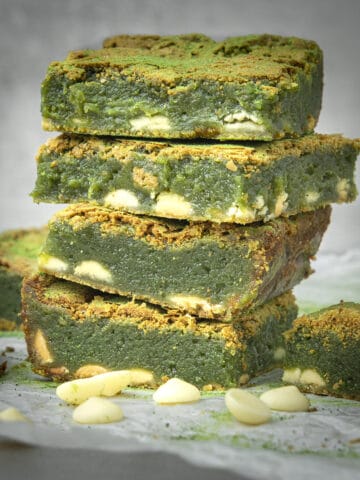Ever wondered what is matcha, what does it taste like and why this vibrant green powder has taken the culinary and health world by storm!?! Well, this comprehensive guide will answer all your questions, from its rich history and unique taste to its many health benefits and endless culinary possibilities! It even teaches you how to make a matcha latte that rivals your favorite café!

Jump to:
- What is Matcha tea?
- What does Matcha taste like?
- History of matcha
- Matcha vs. Green tea
- Matcha tea health benefits
- Does matcha have caffeine
- Where to buy matcha
- What is the difference between matcha grades
- How to make matcha latte
- How to bake with matcha
- How to store matcha
- FAQ
- Related Recipes
- What Is Matcha and What Does It Taste Like (Ultimate Guide)
What is Matcha tea?
Matcha is not just your ordinary green tea. It's a special powdered Japanese tea crafted from the finely ground leaves of the revered camellia sinensis plant, which is the very same plant that gives us various types of traditional green tea. However, unlike regular green tea, the processing of the leaves and the preparation method are different.
You can enjoy the tea powder as a tea, use it to make lattes, blend it into smoothies, or use it to flavor a wide range of desserts.
So what is matcha!? Green tea on a whole new level!
What does Matcha taste like?
Different from any other type of tea, matcha has a distinctive flavor profile that blends earthy, sweet, and umami notes, with a slight hint of grassy vegetal freshness. This unique combination of flavors makes it both invigorating and calming at the same time. However, it's important to note that the grade and quality of the tea can influence the taste (as well as color), with higher grades offering a more refined and complex flavor vs. lower-grade bitterness.

History of matcha
The origins of matcha can be traced back to ancient China, where it was used for medicinal purposes. However, in the 12th century, Buddhist monks brought powdered tea to Japan, and its popularity soared among the aristocracy and samurai warriors. Eventually, it became an essential part of the revered Japanese tea ceremony, known as chanoyu or sado, where the preparation and consumption of this type of green tea became a highly ritualized and meditative practice.
Today, powdered green tea is an integral part of Japanese culture that has transcended borders, captivating tea enthusiasts and foodies around the globe.
Matcha vs. Green tea
What's the difference between matcha and green tea? This is a common question as both teas come from the Camellia sinensis plant. However, they have notable differences in preparation, taste, and consumption.
Matcha is a ground tea made from shade-grown green tea leaves that are carefully handpicked, steamed, and dried before being turned into a vibrant green powder. It's then whisked with water or milk.
In contrast, green tea is a leaf tea crafted from sun-grown leaves and made by steeping them in hot water, which is then discarded.
As for taste, matcha offers a complex profile with strong earthiness and a hint of vegetal flavor. On the other hand, green tea has a more delicate taste, with milder grassy and slightly bitter notes, depending on the variety and brewing time.

Matcha tea health benefits
Beyond its delicious taste and ritual purposes, you may be wondering, is matcha good for you? The answer is yes!
One of the most notable health benefits of this tea is its high level of antioxidants. In fact, it's rich in catechins, a type of antioxidant that helps combat oxidative stress and free radicals in the body. One specific catechin found in matcha called epigallocatechin gallate (EGCG), has even been linked to potentially lowering LDL (bad) cholesterol as well as reducing inflammation and heart disease risk.
Some also say that it boosts metabolism and may aid in weight management. Additionally, the tea contains other important vitamins and minerals, including vitamin C, potassium, and fiber.
Does matcha have caffeine
If you've ever wondered, do matcha lattes have caffeine? The answer is yes. However, the caffeine content can vary depending on the grade of tea used and the serving size. On average, a cup contains about 30-70 mg of caffeine.
With that said, there are benefits of drinking matcha in the morning as it offers you a more balanced caffeine experience compared to coffee, thanks to the presence of L-theanine in the tea. This amino acid promotes relaxation and helps counterbalance the stimulating effects of caffeine, resulting in a state of focused calmness. It's an excellent choice for those seeking a smoother energy boost.
Where to buy matcha
When searching for matcha green tea, you have several options available. Many health food stores now stock it in their tea sections, while Japanese grocery stores and Asian markets almost always offer a wide variety of authentic choices.
Another good place is your local specialty tea shop, where they often carry high-quality matcha powder sourced directly from Japan.
Additionally, many online retailers sell the tea in various grades, allowing you to easily find one that suits your needs. You can even purchase it online directly from producers.
What is the difference between matcha grades
It’s not enough to define what is matcha powder without talking about the three primary grades. Each grade serves a different purpose and experts judge it based on the matcha leaves, processing method, and final texture.
- Ceremonial Grade Matcha: This is the highest quality matcha and is made with the most vibrant green leaves. It's smooth and creamy with mild notes of umami and a slightly sweet taste. Ceremonial grade is most often whisked together with hot water and sipped.
- Premium Grade Matcha: Slightly lower in quality compared to ceremonial grade, it is still perfect for drinking as a tea and is also a great choice for making lattes, smoothies, and baking. With a vibrant green color and a mellow flavor profile, this grade is ideal for those who want high quality at a lower cost.
- Culinary Grade Matcha: This type is specifically intended for incorporating into recipes. It has a slightly stronger flavor that makes it perfect for baking, cooking, and blending into smoothies. Culinary grade is a great cost-effective option that strikes a good balance between quality and affordability. However, you have to be careful using one that has vibrant green color, or, your dessert might not turn out green enough.
How to make matcha latte
What do matcha lattes taste like? Creamy, dreamy deliciousness! And making the perfect latte at home is a lot easier than you probably think! Here's my favorite simple recipe.
Ingredients:
- 1 ½ teaspoons matcha powder
- 1 tablespoon hot water
- 2 teaspoons honey
- ¾ cup hot milk (regular or plant-based)
Instructions:
- Use a fine mesh sieve to sift the powder into a mug.
- Add the hot water and bamboo matcha whisk until there are no lumps.
- Whisk in the honey.
- Pour in the hot milk and whisk to combine. You can also use a milk frother.

How to bake with matcha
Now that we've uncovered what is matcha, let's dive into the culinary possibilities of the ground tea powder! From yummy matcha brownies and white chocolate matcha cookies to mouthwatering ice creams and matcha tiramisu, it adds a colorful and delicious twist.
Matcha baking tips
- Choose High-Quality: The quality of the green tea powder defines the color and flavor of your matcha desserts. While you don't need to use ceremonial grade for baking, using higher quality matcha will produce better results.
- Measure Carefully: A little goes a long way, so use it in moderation to avoid overwhelming your baked goods.
- Sift for Smoothness: Sift the tea powder before incorporating it into the dry ingredients. This helps to remove any lumps and ensures even distribution throughout your batter.
- Create a Paste: Mix the powder with a small amount of water or milk to form a paste before adding it to the other liquid ingredients. This helps it to fully incorporate into the batter.
- Adjust the Liquid: The tea powder can affect the moisture level. If your batter becomes too thick or dry after adding the powder, you may need to slightly adjust the amount of liquid to achieve your desired consistency.
- Balance the Flavor: Matcha has a distinct flavor. To balance the taste, consider adding a touch of sugar, honey, or white chocolate to your recipe. You can also add a dash of vanilla extract. Matcha also goes well with raspberry, black sesame, or mascarpone.
- Frostings and Glazes: You can add the green tea powder to frostings and glazes for a lovely green color and unique flavor. Just be sure to sift the powder before adding it to your recipe.
- Experiment with Combinations: Don't hesitate to get creative with various recipes and ingredients, it pairs well with citrus fruits, coconut, and almonds.
Check out my matcha dessert collection!

How to store matcha
Proper storage is key to preserving the vibrant green hue and exquisite taste of your tea powder. Exposure to light, air, and moisture can cause the tea powder to lose its freshness and flavor. Follow these storage tips:
- Store matcha in an airtight container, preferably dark-colored, to protect it from light.
- Keep it in a cool, dry place, away from heat and humidity.
- Avoid storing the tea near strong-smelling foods, as it can easily absorb odors.
- Use it within a few months of opening the package for the best taste and quality.
FAQ
The term "matcha" literally translates to "ground tea" in English.
It's rich in antioxidants called catechins, particularly epigallocatechin gallate (EGCG), which has been linked to various health benefits. It also contains a good amount of vitamin C, potassium, and amino acids.
Refrigeration is not necessary. However, it can help prolong its freshness if you live in a hot and humid climate.
You can enjoy both hot and cold. Traditionally, it is whisked together with hot water to make a warm tea. However, you can also use it to make a refreshing iced tea or incorporate it into cold beverages and smoothies.
Related Recipes

What Is Matcha and What Does It Taste Like (Ultimate Guide)
Instructions
What is Matcha
- A type of finely ground traditional Japanese green tea with a rich history dating back to the 12th century.
- Made from shade-grown tea leaves that are steamed, dried, and ground into a fine powder.
- Known for its vibrant green color, unique flavor, and many potential health benefits due to its high concentration of antioxidants.
What does Matcha taste like
- It has a distinct flavor profile that sets it apart from other types of green tea.
- Often described as rich, vegetal, and slightly sweet with a hint of bitterness.
- Yet, the taste can vary based on the grade, quality, and processing methods of the tea powder.
How to make Matcha latte
Ingredients:
- 1 ½ teaspoons matcha powder
- 1 tablespoon hot water
- 2 teaspoons honey
- ¾ cup hot milk (regular or plant-based)
Instructions:
- Start by sifting the tea powder into a mug using a fine mesh sieve.
- Add the hot water and whisk with a bamboo matcha whisk thoroughly until no lumps remain.
- Whisk the honey into the mixture.
- Finally, pour in hot milk and whisk once more until everything is well combined. You can also use a milk frother if you prefer.






Sharon Walters
Haven’t tried this yet. But I like your style.